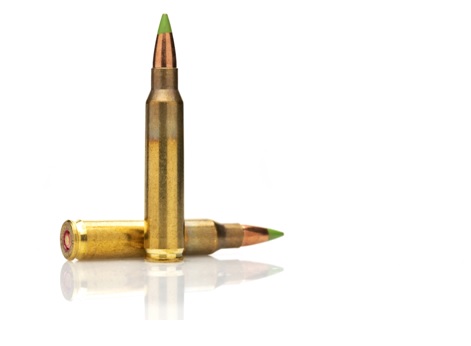There’s a lot of misinformation out there regarding guns and ammo, and you probably didn’t need to read that here to know it to be true.
Only think over the number of times you’ve heard AR-style platforms referred to as “assault rifles” or “high caliber rifles.” It’s cringe-inducing, at best.
So let’s talk about another term that has become controversial as of late: green tip 5.56.
What is it, really, and what is it used for?
What Is Green Tip 5.56?
In the 1970s, NATO wanted to create a STANAG (Standardization Agreement) for a 5.56 cartridge that could be used with service rifles in the NATO sphere of influence, like the M16, FAMAS, and CETME-L.
Just as the US Army Ordnance Department did with the development of the original 5.56x45mm NATO cartridge, it set standards for this “new” 5.56 round in terms of ballistics and penetration characteristics.
NATO wanted a more stable bullet, as well as one that offered improved penetration. To do so, they designed a cartridge, loaded with a 5.56 bullet that had a 7-grain steel tip insert.
This steel tip accomplished two main things. It shifted the center of gravity further back (since steel is less dense than the bullet’s heavier lead core), while also increasing the weight of the bullet to 62 grains.
The other thing the inclusion of this steel tip insert accomplished was creating a bullet with a harder nose - literally. As you might imagine, harder bullets deform (disrupt) less readily on impact, improving their penetration characteristics.
One of the requirements for penetration was that this new round be able to penetrate a .135” steel plate (equivalent to the steel pot of the helmets used by the US Army in WWII) at 800 yards. This is a bit better than the requirement for the 5.56 cartridge in general, which was required to be able to pierce a US helmet at 500 yards.
This new cartridge was originally developed by FN Herstal, which used the nomenclature SS109. Upon adoption by the United States, it was given the designation M855, and the tip was painted green, so that soldiers could easily distinguish it at a glance from other rounds - hence the name, “green tip 5.56.”

When it hit the civilian market, it was extremely popular, and it remains so to this day. This is due in part to the fact that, since the military uses it, it’s widely available and pretty cheap. You can usually score big bulk loads of green tip 5.56 for next to nothing (comparatively speaking, of course).
Also, some ammunition manufacturers call their green tip 5.56 XM855, to distinguish it from what’s officially produced for the military. Not to worry though; there’s no difference in load data between the two.
And, as you know, even though some civilian buyers go wild for “mil-spec” gear, what’s made for the military doesn’t necessarily mean it’s better.
So let’s talk about the bad rap that green tip 5.56 gets for being “armor piercing.”
So, Is It Armor Piercing or Not?
Technically, M855 green tip 5.56 ammo can penetrate some types of armor - like the steel helmet mentioned above. But it wasn’t designed for that purpose, and that is light armor anyway.
Remember, even a standard .223 Rem FMJ round off the shelf from a civilian gun shop would probably punch right through a US M1 steel pot at 100 yards, too. Does that make .223 FMJ armor piercing? We should hope not.
Compared to ammo like “black tip” 5.56, which has a tungsten core and is designed for armor piercing applications, green tip 5.56 is somewhat anemic. It can penetrate some armor, but that isn’t its purpose, and it isn’t really good at it, anyway.
Why Don’t Some Ranges Allow It?
If you’re familiar with it, then you might know that some ranges don’t allow green tip 5.56 ammo. Even though it isn’t really armor-piercing, there’s a good reason for this limitation.
Green tip 5.56 is really hard on steel targets and can punch through a lot of them. It’s also really hard on backstops, requiring them to be replaced more frequently.
So some ranges just don’t allow it. Always consult the rangemaster before firing any green tip at a range. It may not be allowed, and it could potentially even be dangerous.

What Are the Practical Applications of Green Tip 5.56?
With all of this said, green tip 5.56 is pretty affordable and you can usually get good deals on surplus ammo.
Because it’s cheap and fairly accurate, it’s suitable for training and high-volume plinking applications. It’s not the best for competition because it can be hard on targets and might not even be allowed, anyway.
But, if all you’re doing is burning brass and plinking on a range where it is allowed, it's fine ammo. And you can stock up on it here at Bucking Horse Outpost.

